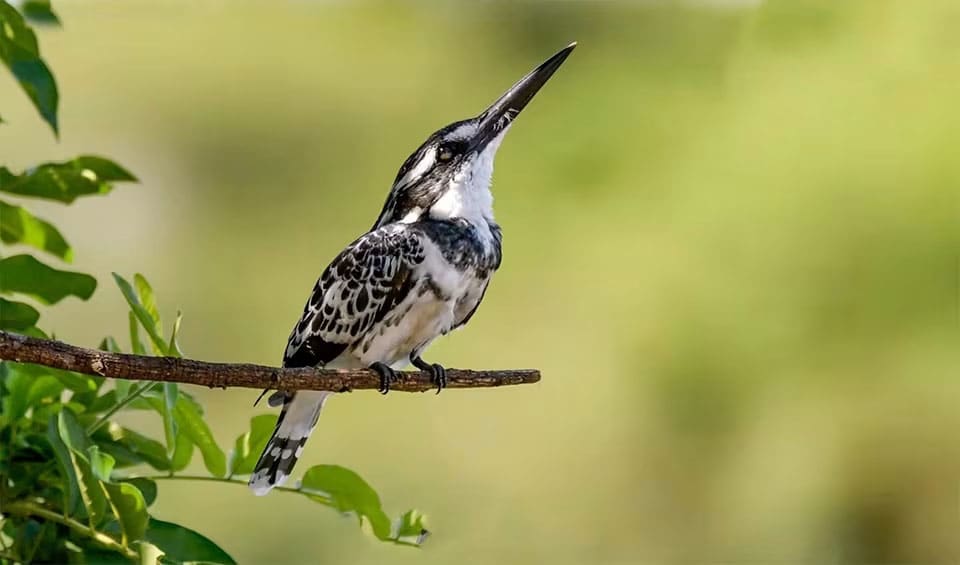Renowned for its striking black and white plumage and distinctive crest, it holds the distinction of being the smallest among the three most numerous kingfisher species. This charismatic bird is commonly found in habitats adjacent to water bodies, such as rivers, lakes, ponds, and streams, where it displays its remarkable hunting prowess.
One of the most remarkable behaviors exhibited by the pied kingfisher is its unique hunting technique. Unlike other kingfisher species that typically dive from perches to catch their prey, the pied kingfisher employs a different strategy. It is known for its ability to hover effortlessly over clear water bodies, using its keen eyesight to spot small fish, crustaceans, and aquatic insects swimming below the surface. Once it locates its prey, the pied kingfisher plunges headfirst into the water with remarkable precision, emerging moments later with its catch secured firmly in its bill.
However, the pied kingfisher’s culinary skills extend beyond mere hunting prowess. This adaptable bird is capable of consuming its prey while in flight, a feat that sets it apart from other members of the kingfisher family. This remarkable ability allows the pied kingfisher to snatch prey from the water’s surface and immediately take to the air without the need to perch and consume its meal.
While the pied kingfisher is primarily a resident species within its native range, it also engages in seasonal migrations, particularly in response to changing environmental conditions or resource availability. Despite its relatively small size, the pied kingfisher is a swift and agile flyer, capable of reaching speeds of up to 50 hm/h (31 mph) during its migratory journeys.
Distribution
 Afghanistan
Afghanistan Angola
Angola Bahrain
Bahrain Bangladesh
Bangladesh Benin
Benin Bhutan
Bhutan Botswana
Botswana Burkina Faso
Burkina Faso Burundi
Burundi Cambodia
Cambodia Cameroon
Cameroon Central Af. Rep.
Central Af. Rep. Chad
Chad China
China Congo-Brazzaville
Congo-Brazzaville Cyprus
Cyprus Côte D’ivoire
Côte D’ivoire DR Congo (Kinshasa)
DR Congo (Kinshasa) Djibouti
Djibouti Egypt
Egypt Equatorial Guinea
Equatorial Guinea Eritrea
Eritrea Eswatini
Eswatini Ethiopia
Ethiopia France
France Gabon
Gabon Gambia
Gambia Ghana
Ghana Greece
Greece Guinea-Bissau
Guinea-Bissau Guinea
Guinea Hong Kong
Hong Kong India
India Iran
Iran Iraq
Iraq Israel
Israel Jordan
Jordan Kenya
Kenya Kuwait
Kuwait Laos
Laos Lebanon
Lebanon Lesotho
Lesotho Liberia
Liberia Macao
Macao Malawi
Malawi Mali
Mali Mauritania
Mauritania Mozambique
Mozambique Myanmar
Myanmar Namibia
Namibia Nepal
Nepal Niger
Niger Nigeria
Nigeria Oman
Oman Pakistan
Pakistan Poland
Poland Qatar
Qatar Rwanda
Rwanda Saudi Arabia
Saudi Arabia Senegal
Senegal Sierra Leone
Sierra Leone Somalia
Somalia South Africa
South Africa South Sudan
South Sudan Sri Lanka
Sri Lanka Sudan
Sudan Syria
Syria São Tomé & Príncipe
São Tomé & Príncipe Tanzania
Tanzania Thailand
Thailand Togo
Togo Turkey
Turkey UAE
UAE Uganda
Uganda Ukraine
Ukraine Vietnam
Vietnam Zambia
Zambia Zimbabwe
ZimbabweAnything we've missed?
Help us improve this page by suggesting edits. Glory never dies!
Suggest an editGet to know me
Terrestrial / Aquatic
Altricial / Precocial
Polygamous / Monogamous
Dimorphic (size) / Monomorphic
Active: Diurnal / Nocturnal
Social behavior: Solitary / Pack / Herd / Flock
Diet: Carnivore / Herbivore / Omnivore / Piscivorous / Insectivore
Migratory: Yes / No
Domesticated: Yes / No
Dangerous: Yes / No




